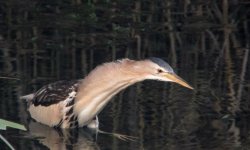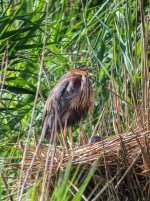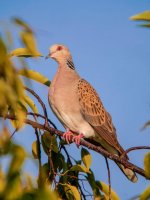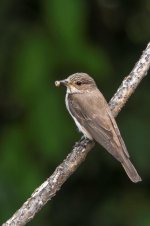I have been conscious that my review of the Zeiss Harpia scope (https://www.birdforum.net/showthread.php?t=369982) contained virtually no information about digi-scoping with Harpia. To put right this omission I have been on the lookout for suitable information published elsewhere, and found an article by Walter Schultz, published in the April 2019 issue of the German-language magazine Vögel, which, following translation, I have adapted for use here. I thank Herr Schultz and Vögel magazine for allowing the use of the article and photographs.
Zeiss has positioned the new Victory Harpia scope as its top-of-the-line spotting scope offering quickly changeable magnification and focus adjustment in a package delivering a class-leading field of view at low magnifications, and extremely high image quality at maximum magnification. In this way the flagship 23-70x95 and the smaller, lighter 22-65x85 offer easy ‘search and capture’ at lower magnifications and a rapid switch to the higher magnifications to examine details.
But how does Harpia perform when digi-scoping?
Digi-scoping makes use of the long focal length, and therefore the high magnification possibilities of spotting scopes, combined with a light-weight camera system, and is particularly suitable when a photograph is needed of a stationary or slow-moving bird at a relatively long distance from the observer. Laboratory tests have confirmed that a good digi-scoping set-up can outperform the resolution of a big and heavy photo-lens. To achieve this performance it is essential to stabilize the system using a good tripod-head combination. This combination cannot be very lightweight, but neither does it have to be really heavy either. Some middleweight carbon-fibre tripods will do the job, meaning that the shaking caused by pressing the shutter-button should be eliminated within 1,5 to 2 seconds. Some heavyweight aluminum tripods maintain the shaking for more than 2 seconds and shouldn´t be used for digi-scoping at all. If possible, a remote-control is the best solution, and is really essential for extensive digi-scoping. Otherwise a selftimer will help in most casual situations, but unfortunately most cameras have limited self-timer options today, with often only 2, 5, and 10 seconds available. However, Olympus OMD Models can be adjusted in steps of 0.5 seconds to suit any tripod-head’s s stabilizing ability, which is a great advantage.
Both Harpia models use the same slim-line eyepiece, so all digi-scoping adapters fit both models and both Harpia models can be connected, via an objective filter thread, to any lightweight camera. There are three different Zeiss adapters with filter thread sizes of M 49, M 52 and M 58 mm available which are relatively inexpensive. Other thread sizes can be achieved by using step-up rings. Those rings can stay on the objective lens of the camera, functioning as a sunshield and lens protection during normal operating conditions. In case of digi-scoping the camera can easily be attatched to the eyepiece of the Harpia telescope.
Choosing the right camera is not an easy task. There are many different models, and the variety of objective lenses is even bigger. Everyone has his/her preferences and tastes, according to the never- ending discussions about what is the ‘right’ set-up.
But some principle rules do apply to all: small sensors normally harmonize better with the eyepiece of a telescope than full frame or even medium format sensors. Exactly for that reason smartphones work so well for digi-scoping. System-cameras with MFT sensors like the Olympus OMD Cameras are lightweight and therefore easy to carry. Their image stabilization system is integrated into the body and supports digi-scoping, as do the Panasonic Lumix-G models. We got excellent results with those MFT cameras using the Olympus Zuiko f1.8 17 mm and f1.8 25 mm lenses. Our preferred set-up was the Olympus OMD 10 Mark II with f1.8 25 mm Zuiko lens, because of its small size, low weight and very attractive price level, despite the somewhat complicated handling procedures of that camera.
Some APS-C camera models are good options, for example the Sony Alpha 6500 because of its IS System, small size and low weight, and it is not very expensive, especially with the Sigma f2.8 30 mm or the better Sony f2.0 28mm objective lens. Even better results are achieved with the Sony Zeiss f2.0 35mm or the Zeiss Loxia f2.0 35mm.
Nobody has the budget to test all the different combinations of cameras and lenses. Some lenses show some vignetting in the corners of the picture which is not a real problem, but more of an unfamiliar effect, easily solved by even the cheapest image processing software today. Basically full frame objective lenses on APS-C sensor cameras show less vignetting problems than those objective lenses designed for APS-C cameras. In general we recommend fixed focal-length objective lenses between 17 and 25mm for MFT, and 28 through 40mm for APS-C sensors. We clearly prefer mirrorless cameras, and although DSLR´s work for digi-scoping as well, mirror-shake needs to be avoided - for example, by working under Live-View Mode.
Summarizing we found that digi-scoping with the Harpia can deliver excellent results, even from long distances, provided that there is enough time available to prepare everything in the right way. A major advantage of photographing from these long distances is that the pictures show undisturbed and unstressed birds.
The photos below (my favourite is the Lesser Kestrel), from left to right, are
1. Little Bittern, taken with Sony 6500, Sony-Zeiss 35 mm 2.8
2. Purple Heron, taken with iPhone 6s.
3. Turtle Dove, taken with Olympus Zuiko 25 mm 1.8 and Panasonic Lumix G 9
4. Lesser Kestrel, taken with Sony 6500 and Sony 28 mm 2.0
5. Spotted Flycatcher, taken with Sony 6500, Sony-Zeiss 35 mm 2.8
Lee
Zeiss has positioned the new Victory Harpia scope as its top-of-the-line spotting scope offering quickly changeable magnification and focus adjustment in a package delivering a class-leading field of view at low magnifications, and extremely high image quality at maximum magnification. In this way the flagship 23-70x95 and the smaller, lighter 22-65x85 offer easy ‘search and capture’ at lower magnifications and a rapid switch to the higher magnifications to examine details.
But how does Harpia perform when digi-scoping?
Digi-scoping makes use of the long focal length, and therefore the high magnification possibilities of spotting scopes, combined with a light-weight camera system, and is particularly suitable when a photograph is needed of a stationary or slow-moving bird at a relatively long distance from the observer. Laboratory tests have confirmed that a good digi-scoping set-up can outperform the resolution of a big and heavy photo-lens. To achieve this performance it is essential to stabilize the system using a good tripod-head combination. This combination cannot be very lightweight, but neither does it have to be really heavy either. Some middleweight carbon-fibre tripods will do the job, meaning that the shaking caused by pressing the shutter-button should be eliminated within 1,5 to 2 seconds. Some heavyweight aluminum tripods maintain the shaking for more than 2 seconds and shouldn´t be used for digi-scoping at all. If possible, a remote-control is the best solution, and is really essential for extensive digi-scoping. Otherwise a selftimer will help in most casual situations, but unfortunately most cameras have limited self-timer options today, with often only 2, 5, and 10 seconds available. However, Olympus OMD Models can be adjusted in steps of 0.5 seconds to suit any tripod-head’s s stabilizing ability, which is a great advantage.
Both Harpia models use the same slim-line eyepiece, so all digi-scoping adapters fit both models and both Harpia models can be connected, via an objective filter thread, to any lightweight camera. There are three different Zeiss adapters with filter thread sizes of M 49, M 52 and M 58 mm available which are relatively inexpensive. Other thread sizes can be achieved by using step-up rings. Those rings can stay on the objective lens of the camera, functioning as a sunshield and lens protection during normal operating conditions. In case of digi-scoping the camera can easily be attatched to the eyepiece of the Harpia telescope.
Choosing the right camera is not an easy task. There are many different models, and the variety of objective lenses is even bigger. Everyone has his/her preferences and tastes, according to the never- ending discussions about what is the ‘right’ set-up.
But some principle rules do apply to all: small sensors normally harmonize better with the eyepiece of a telescope than full frame or even medium format sensors. Exactly for that reason smartphones work so well for digi-scoping. System-cameras with MFT sensors like the Olympus OMD Cameras are lightweight and therefore easy to carry. Their image stabilization system is integrated into the body and supports digi-scoping, as do the Panasonic Lumix-G models. We got excellent results with those MFT cameras using the Olympus Zuiko f1.8 17 mm and f1.8 25 mm lenses. Our preferred set-up was the Olympus OMD 10 Mark II with f1.8 25 mm Zuiko lens, because of its small size, low weight and very attractive price level, despite the somewhat complicated handling procedures of that camera.
Some APS-C camera models are good options, for example the Sony Alpha 6500 because of its IS System, small size and low weight, and it is not very expensive, especially with the Sigma f2.8 30 mm or the better Sony f2.0 28mm objective lens. Even better results are achieved with the Sony Zeiss f2.0 35mm or the Zeiss Loxia f2.0 35mm.
Nobody has the budget to test all the different combinations of cameras and lenses. Some lenses show some vignetting in the corners of the picture which is not a real problem, but more of an unfamiliar effect, easily solved by even the cheapest image processing software today. Basically full frame objective lenses on APS-C sensor cameras show less vignetting problems than those objective lenses designed for APS-C cameras. In general we recommend fixed focal-length objective lenses between 17 and 25mm for MFT, and 28 through 40mm for APS-C sensors. We clearly prefer mirrorless cameras, and although DSLR´s work for digi-scoping as well, mirror-shake needs to be avoided - for example, by working under Live-View Mode.
Summarizing we found that digi-scoping with the Harpia can deliver excellent results, even from long distances, provided that there is enough time available to prepare everything in the right way. A major advantage of photographing from these long distances is that the pictures show undisturbed and unstressed birds.
The photos below (my favourite is the Lesser Kestrel), from left to right, are
1. Little Bittern, taken with Sony 6500, Sony-Zeiss 35 mm 2.8
2. Purple Heron, taken with iPhone 6s.
3. Turtle Dove, taken with Olympus Zuiko 25 mm 1.8 and Panasonic Lumix G 9
4. Lesser Kestrel, taken with Sony 6500 and Sony 28 mm 2.0
5. Spotted Flycatcher, taken with Sony 6500, Sony-Zeiss 35 mm 2.8
Lee
Attachments
Last edited:









